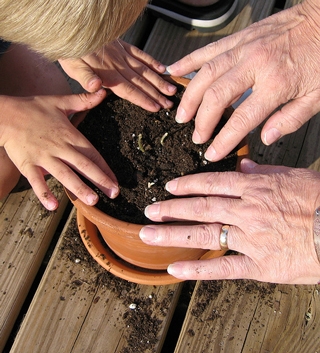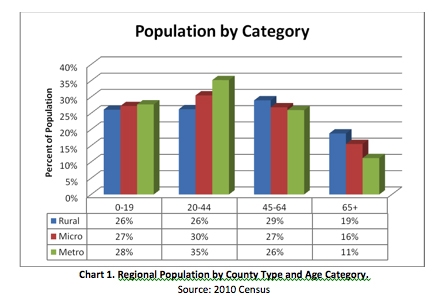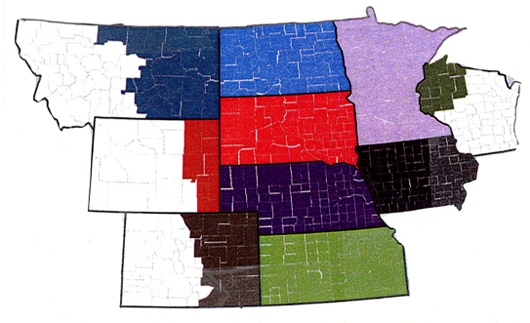|
|
An Age 'Valley'
Confronts the Great Plains
by Jon M. Bailey, Daily Yonder
February 10, 2012

Picture Credit: Birgit Sabo
The very young and the elderly
make up more of the rural population in the Great Plains than they do
in cities and larger towns.
A region's
needs and its potential come, in part, from the age distribution of the
people who live there. In the Great Plains and Midwest, rural regions
are disproportionately elderly. Now's the time to change public policy.
Rural areas of Great Plains and Midwest are lodged between bookend
generations, the youngest and oldest, with a demographic valley in
between.
The 2010 Census shows elderly residents (over age 65) are more likely
to live in rural counties than are younger adults, yet more than a
quarter of the region’s rural population is under the age of 20. These
bookend generations generally require the most local services and
resources, especially for health care and education.
Even as they need resources to support the very young and elder
citizens, rural areas in the Plains and Midwest are continuing to lose
population, while smaller cities and metropolitan areas expand. These
realities present both immediate and long-term challenges for the Great
Plains region. How will rural areas, shrinking in population, provide
the services that are necessary for communities to thrive?
The age distribution of any region’s population has significant
implications. Using data from the 2012 Census, the Center for Rural
Affairs has studied demographic differences among counties – rural,
micropolitan and urban – across the Great Plains and western Midwest,
with an eye toward understanding and anticipating needs within the
region. (The full report and state-by-state data may be found here.)
According to the National Center for Education Statistics, the average
educational attainment level in rural areas is lower than the
nationwide average, particularly for post-high school, bachelor degree
or higher education. This discrepancy was true for all adult age
groups. For example, 21 percent of rural adults ages 25 to 34 had a
bachelor’s degree or higher compared to 34 percent in cities and
suburbs. As educated young adults flock to micropolitan and
metropolitan counties, investment will most likely flow into those
areas to create jobs and opportunities and to meet the needs of the
expanding population. Conversely, such investments are unlikely in
rural areas of the region. Rural communities and public policy must
find alternative methods to create rural economic opportunities.
At a time when rural development programs should be established to meet
these demographic challenges, federal contributions to rural
development are plummeting, and have been for years; almost one-third
of the USDA Rural Development budget has been cut since 2003. And
Congress is considering making even further cuts to already-bare-bones
rural development programs. Congress has recently taken away one-third
of the funds for the popular Value Added Producer Grant program as well
as all the money for the Rural Microentrepreneur Assistance Program.
The USDA only uses about 1.7 percent of its budget for rural
development, equaling about $40.68 for every rural resident. As
Congress debates and writes the new Farm Bill rural development must be
seriously funded and constructed to help create jobs and opportunities
in rural areas.
Rural communities also have a role to play in helping develop their
futures. Much has been written about community foundations and the role
they can play in promoting economic development and economic
opportunities in rural communities.
Initiatives like Nebraska’s LB 840, which allows communities to impose
a small sales tax on themselves for economic development purposes, also
allows communities to marshal the resources for what needs to be done
in their communities to address economic problems and demographic
shifts. Public policy and community investments should not be mutually
exclusive; in fact, for rural communities to meet their economic and
demographic tests, both are needed.
The chart below outlines each of the county types described above and
the distribution of their populations by age group for the region
examined (with rural-micropolitan-metropolitan from left to right in
each group of bars).

Center for Rural Affairs
This chart, drawn from 2010
Census data, shows that young adults predominate in cities and larger
towns of the Great Plains and Midwest.
Metropolitan: Any county
designated as part of a Metropolitan Statistical Area (MSA) based on
the 2010 Census. Each MSA must have at least one urbanized area of
50,000 or more inhabitants.
Micropolitan: Counties
based around a core city or town with a population of 10,000 to 49,999.
A micropolitan area may consist of more than one county depending upon
economic, social and cultural connections.
Rural: Counties with a
population center of less than 10,000 inhabitants and not included in
either a metropolitan or micropolitan area.
This chart shows three basic facts related to age distribution in the
region:
• For the 0-19 years of age cohort, the three county
types are essentially equal. While metropolitan and micropolitan
counties will have more children within their borders, the proportion
of the population made up of children is roughly the same across all
three county types. However, resources for the services necessary for
children are often inequitably distributed to rural areas (See, for
example, battles over K-12 education aid in many states and the
resulting consolidation or closing of rural schools).
• The 20 to 44 years of age cohort of young, working
age adults is where rural areas begin to lag behind metropolitan and
micropolitan counties. While the proportion for this age cohort is
equal to the proportion of the younger age group in rural counties, the
share of residents in this age group is significantly higher in both
metropolitan and micropolitan counties. This is likely due to the
migration of young, working age adults to these counties often from
rural areas for jobs and education and the retention of residents in
this age group. In metropolitan counties of the region, nearly
two-thirds of the population is less than 45 years of age.
• Rural areas are older. Rural areas have a larger
proportion of their population in the two oldest age groups (45 years
of age and older) than do metropolitan and micropolitan counties. The
largest portion of the regional rural county population is the middle
age cohort 45 to 64 years of age. It is likely many of these rural
residents are the parents of the younger 20 to 44 age cohort who are
abandoning rural areas in large numbers.
Both metropolitan and micropolitan counties of the region have
significant portions of their population in this age group (ages
45-64), but proportions are slightly lower than in rural counties.
Rural counties of the region have a significantly larger portion of
their population 65 years of age and older (19%), especially compared
to metropolitan counties of the region (11%). With nearly half the
rural population 45 years of age and older, the needs of rural
communities of the region and the services required in those
communities are significantly different than in the urban areas.
Since the 1980 Census, the Center for Rural Affairs has analyzed Census
data for a multi-state region. For the 2010 Census analysis, selected
counties in Colorado, Montana, Wisconsin and Wyoming have been added to
the examined region to obtain a broader view of the region. The
geographic scope of this analysis is shown in the map below.

Center for Rural Affairs
This map shows the counties
included in the Center for Rural Affairs' new study of demographics in
the Great Plains and Midwest.
The relative
age of rural residents now requires and will continue to require
emphasis on a special set of services. Access to public transportation,
health care, retirement security and the stability of programs tied to
senior populations will continue to be critical for many rural
communities.
In addition, the relatively large rural population of children suggests
the need to maintain or, in some cases, enhance those services and
resources targeted to our youngest citizens. School funding, pediatric
health care services (including the severely resource-deficient rural
mental health system), parks and recreation programs and nutrition
programs are examples of services and resources targeted to rural
children that will be a challenge for rural communities to maintain or
enhance.
How rural communities of this region address the economic and public
financing challenges presented by these demographics is, in our
opinion, one of the defining issues of the near future. How communities
and state and local governments provide the services necessary for
their youngest and oldest rural citizens with a small working and
tax-paying middle will help determine the well-being of the rural parts
of the region. Addressing the issue of the “valley population will help
determine the future of the rural Great Plains and Midwest.
More Information on US Health Issues
|
|



